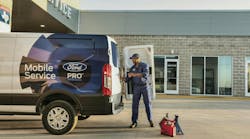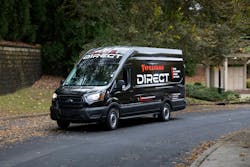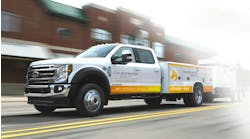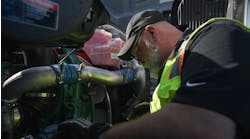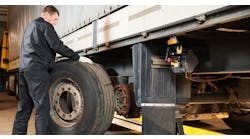This is Part Two of a two-part story. Read Part One here.
Torque by Ryder, the retail mobile fleet maintenance business unit for Ryder, has had enough previous experience with mobile technicians to know that they are a different breed from your typical stationary tech, albeit one that can pay dividends in speed and convenience for customers. But to make these technicians as efficient as possible, driving the “shop” to the customer is only the beginning.
“These technicians are not just technicians; they’re salespeople, customer service agents, billers, schedulers,” said Jordan Wagner, VP and GM of Torque. “They’re basically running their own little business out of these trucks. Now we have the support setup to help them, but at the end of the day when they’re out in that lot, they’re making decisions based on what they feel is best.”
You can’t make those decisions for them, but management can better inform the mobile techs with the right tools in the following areas:
Diagnostics
From an environmental standpoint, having containment equipment to prevent oil or other fluids from spilling onto customer property—or anywhere else—is at the top of the list, but Wagner said the right diagnostic tools are right beside that.
“All these trucks now are computerized, so if you don’t have a good diagnostic tool to be able to link into the systems and see what’s going on, it makes it very challenging if we’re not out just running through PMs,” Wagner explained.
Ryder’s traditional shop tech work is “typically pretty vanilla” because the trucks have very similar specs, but there’s no telling what mobile ones will face each day, Wagner explained. To aid the mobile techs, the company internally developed a scan tool.
“As we’re out working on really anything and everything, we’ve realized the need to have more manufacturers loaded and more diagrams loaded,” Wagner noted.
Dash cams
Making sure techs have the right gear for the job is a given. Getting to the job requires an altogether different type of tool—and mindset. As a mobile tech manager, you have to think like a fleet owner. That likely means adopting the AI-enabled advanced driver assistance systems and dash cams to mitigate negative driving behavior and accidents.
Torque specs their Sprinters with all the available factory ADAS, like lane assist, and equips them with dual-facing Lytx dash cams integrated into their Geotab telematics platform. Through this, management can monitor hard braking, harsh accelerating, and texting while driving. Safety is of course critical for any commercial vehicle operation, but an accident involving a mobile van or truck is akin to having a shop bay abruptly shut down. This affects the mobile tech’s pay and the provider’s bottom line, but more importantly, it impacts the customer who can’t get their vehicle fixed expeditiously. Other departments at the maintenance provider would also have to interrupt other tasks to find a replacement unit and repair the damaged one.
This is a big reason why Southern Tire Mart (STM) adopted Azuga’s driver safety solution, which includes monitoring and coaching. Azuga was acquired by Bridgestone in 2021.
“The fewer accidents our drivers are involved in, the more efficient our fleet department can be based on not having to deal with repairing or replacing wrecked units, noted Rusty Robertson, safety manager at Southern Tire Mart. “They can focus on changing out trucks with high mileage instead of trying to figure out how and where to get units repaired.”
Using Azuga’s fleet dash cam, STM cut speeding events by 54% and the total time drivers sped by 43%.
Read more: All AI dashcams the true winner in technology comparison study
Firestone Direct also uses Azuga, though Hinton said they don’t use the inward-facing cams, which utilize more AI features, such as detecting seat belt use, smoking, and distracted driving.
“We decided to stay away from that just because we did some studying, and we didn’t really want to have any turnover,” explained Seth Hinton, Firestone Direct fleet analyst, who had read of accounts where other companies’ drivers had quit due to privacy concerns. The mobile techs only drive about 15% of the day, so in-cab behavior was less of a concern, he added.
Dash cam developers often dismiss this “Big Brother” trope, saying the system doesn’t retain all video, only segments where a crash or pre-determined tolerance, like speeding, was exceeded. Explaining how the technology works typically gets drivers to accept the cameras.
Speaking of privacy, an accident is anything but. Anyone driving by a wreck can see who operates the commercial vehicle involved.
“These trucks stick out like a sore thumb,” Wagner said of Torque’s orange- and blue-colored work trucks. He added the well-known name of Ryder emblazoned on the side also makes the vehicles a potential target for litigious scammers hoping to cause an accident and steal a payout. The dash cams would provide evidence of what really happened.
STM reported that the Azuga solution helped exonerate their drivers in 15 separate accidents.
eDVIRS
Pre- and post-trips may be new to a mobile technician, and electronic driver vehicle inspection reports can help quickly and accurately guide a mobile tech through the process so they can get to the customer’s jobsite. They can also integrate into their company’s maintenance management system, which they should know how to navigate.
Bryant Maxey, senior product marketing specialist at Zonar, encourages this method.
“That way all defects flow right into one familiar platform where work orders are created, prioritized, and closed,” Maxey said. “Plus, all eDVIRs are documented and electronically stored, making access to previous reports easy.”
Inspection reports can also be customized to include inventory tools before and after a job, as well as ensuring jump starters, generators, and welding machines work.
Telematics
Hinton expressed that maintenance of Firestone Direct’s mobile assets was made easier overall because of the transparency provided by Azuga’s platform. From a smart device or laptop, a manager can view any vehicle’s engine hours, which, for assets that idle more than they drive, is crucial to maintaining engine health. Tracking miles alone could shorten an engine’s life.
“Idling actually cuts your oil change [intervals] pretty much in half,” Hinton said. “It’s much more rough on an engine than actually traveling and going places with it.”
These vehicles may also be a target for theft. STM said GOS tracking helped recover a stolen vehicle, and in another case, the geofencing helped identify the culprit of a tire theft at an STM store.
Gamification
On the positive side, telematics data also allows managers to incentivize mobile techs to drive more safely based on bad habits like speeding and harsh braking. The fleet can choose the specific KPIs they want to address.
“They could certainly use this as either a stick or a carrot,” said Robin Kinsey, senior manager of marketplace sales at Geotab, who advocated for the “carrot of gamification” where fleets provide rewards for good behavior versus punishing the bad.
Read more: Game On: Gamifying the shop
Firestone Direct does opt for the carrot approach.
“We can look at driver scores daily,” Hinton noted. “The data is really unlimited for us, as far as what we can get from Azuga.”
Using that data, Firestone Direct initiated a bonus program for mobile techs. It is based on the safest market, not individual behavior. The top 10 also received a cash bonus.
“Harsh braking is usually the leading factor of accidents, so it represents 50% of their overall score and speeding represents 30%,” Hinton said. They track harsh accelerating, too, but vans hauling tire changers don’t have the zip to make that a common infraction.
Hinton noted that after instituting the safe driving, “we saw some of our highest scores that we’ve ever seen.” After the contest concluded, the scores dipped. They went back up when the program began again.
Torque also rewards good driving behavior by creating a safety scorecard and rewarding the safest driver of the month based on the number of events and coaching opportunities they had.
Construction company Brubacher Excavating, Inc. has a number of support assets, including lube and service trucks, and uses Zonar’s Fleet Management platform. The fleet bakes in driving and risk management into drivers’ annual reviews. Idle reduction also plays a big role.
“If they are under 5% idling time for the month, we reward them with extra vacation time, giving time back to the drivers from what they saved the company in non-productive idling time,” explained Greg Balamuta, Brubacher dispatch manager. “It didn’t take long for the drivers to understand and catch on to see the value of what we were trying to help them and us accomplish.”
Balamuta advised that any fleet looking to gamify driving should “always keep safety and performance at the forefront of the incentives and gamification program. The metrics we measure are all important while we keep safety and performance goals obtainable.”
